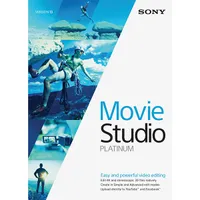A Guide To Inexpensive Video Editing Software
In the first two parts of our series, we only spent your money on hardware and the software was free. But sometimes you get what you pay for, so perhaps its time to spend a little.
Sony Movie Studio
Apparently, what happened in Vegas didn’t stay in Vegas this time. Sony Movie Studio is the new name for Vegas, a product the company has been selling for more than 12 years. But it’s the same workbench. This version is apparently not much more than another de-featured adaptation of the venerable Vegas Pro. Sony didn’t write it, but acquired the code-base from creator Sonic Foundry.
Vegas/Movie Studio began life as an audio cutting tool, to which video was later added. So, it still feels like Digital Audio Workstation (DAW) software, except it has no MIDI (Musical Instrument Digital Interface) chops. Movie Studio applies visual effects with a plug-in paradigm that evokes an audio mixing desk with a patch-bay.
The latest Movie Studio (version 13) architecture is natively 64-bit, and it’s a bit faster than Vegas was. It does handle 4K media astonishingly fast compared to others in this price range.
You can customize your workspace quite a bit. But some of the functions one sees in peers are missing. Others are there, but you wouldn’t know it from the interface. For example, you can change the play-out rate of a clip to fit a hole in your timeline with a keyboard hack that “rubberizes” the media file, but there’s no obvious button or switch to get you into the mode. Clip stabilization is hiding somewhere there too. Confusing.
I find the interface perplexing and pokey, decidedly old school, but not in a good way. Images and source videos live in film-style bins, but you can’t drop other types of media or effects there. Most of the switches and levers look like an alien spaceship. You’ll soon find yourself scratching your head, muttering, “What’s this do?” about some control. You can toggle your cursor to give you a pop-up explanation window or—in some cases—hover over icons to get a pop-up cheater. What you’ll discover is that several of the widgets appear to do the same things.
Even with the explainers, operating the editor feels like swimming in honey. Or like that dream where you flick your black coat-tails over the piano bench at Carnegie Hall as you sit to perform the Rachmaninoff Concerto #3, only to discover your hands have morphed into permanent boxing gloves. This thing is sluggish.
It’s a timeline-only editor. And getting around in the timeline takes some getting used to. There’s no thumbnail/storyboard view. You stay in one terminal view; you'll find no separate windows for ingest or export. That’s counter-intuitive. It seems like a very linear workflow for such a specifically nonlinear utensil. Sony has updated its Trim/Split method, but that’s hardly a breakthrough.
Get Tom's Hardware's best news and in-depth reviews, straight to your inbox.
Got two eyes? MovieStudio gives you 3D stereoscopic video editing at this low price point. But so does MAGIX Movie Edit. Plus, CyberLink’s PowerDirector isn’t really all that much more costly, and it runs 3D circles around MovieStudio.
You can wrangle up to 20 tracks. That’s probably enough (it’s certainly a decent value for the price). More expensive competitors offer hundreds, though. Audio “Voices” display waveforms, but you can’t really use this to visually edit audio very well. You’ll have to hunt around to turn on deeper audio-sweetening gizmos, but they are there. Many of these are derived from Sonic Foundry Sound Forge.
When you’ve locked your cut (or given up fighting with it), you can export via the “Make Movie” function to YouTube, or to attached storage. Sony experimented with housing its own “Pixelcast” sharing service, but bagged it this past April after less than two years in the game. At least you can still handily burn a DVD or Blu-ray.
Sony hosts a marketing department-feeling “forum” to supposedly service users. But it looks like they are more interested in up-selling customers than helping them.
If you buy Sony Movie Studio, buy a crash helmet. In other words, save your work early and often. The package is prone to system hangs. Be sure to reach out frequently to the Sony Creative site to patch your system. At least that means your software is supported and backed by working developers. That’s no small thing. A few lesser competitors are just riding out old investments, trying to squeeze a few last shekels before folding their tents. Sony still cares about brand reputation. It’s still Vegas, baby.
Current page: Sony Movie Studio
Prev Page Corel VideoStudio X7 Pro And Ultimate Next Page MAGIX Movie Edit Pro 2014-
aebome It would help if you link to the other two articles in the series so we don't have to rummage through the site to see if we can find them. That's just basic.Reply -
beetlejuicegr unfortunately for me as a tv news director/ control i had the bad luck (you will see what i mean ) to learn montage on Final Cut on Macs. After that software, all the rest in pc are Crap! :( and i am a known anti-apple user ;/Reply -
Lord Darren In the interest of potential longterm planning, wouldn't it be prudent to familiaize oneself with Premiere from the get-go? In theory this should ease the learning curve if and when you make the jump to CS or CC.Reply -
sm_sum I checked the guide, it's very well written and very comprehensive. I came across free software that have good editing features. Maybe check them out: http://listoffreeware.com/list-best-free-video-editors/Reply

